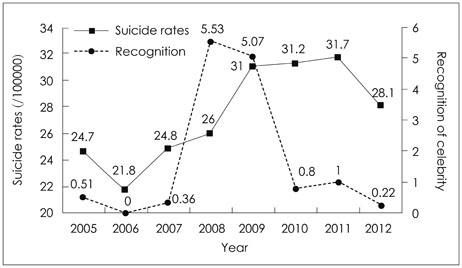J Korean Neuropsychiatr Assoc.
2015 May;54(2):216-221. 10.4306/jknpa.2015.54.2.216.
Association between Media Reporting and a Lower Suicide Rate in 2012
- Affiliations
-
- 1Department of Psychiatry, Asan Medical Center, University of Ulsan College of Medicine, Seoul, Korea.
- 2Department of Clinical Epidemiology and Biostatistics, Asan Medical Center, University of Ulsan College of Medicine, Seoul, Korea.
- 3Department of Psychiatry, Sungkyunkwan University School of Medicine, Samsung Medical Center, Seoul, Korea. suhurhong@gmail.com
- KMID: 2343901
- DOI: http://doi.org/10.4306/jknpa.2015.54.2.216
Abstract
OBJECTIVES
A recent study conducted by the Korea National Statistical Office (KNSO) reported that the suicide rate in Korea decreased in 2012. The aim of this study was to investigate the association between the decrease in suicide rate and media reporting of suicide events.
METHODS
Data on suicide rates were obtained from the KNSO. Correlation between suicide rate and celebrity suicide events, number of media reports on suicide, and suicide searches was compared. Data were analyzed using Pearson's correlation coefficient.
RESULTS
The number of celebrity suicide events and recognition of celebrity decreased in 2012. Pearson's correlation test showed a significant positive correlation between the monthly number of media reports on suicide and the suicide rate (daily newspaper r=0.619, p<0.001 ; broadcast r=0.393, p<0.001). The number of suicide searches showed association with celebrity suicide events.
CONCLUSION
The suicide rate may be influenced by the number of media reports on suicide events. Establishing guidelines for media reporting on these events could help to decrease the suicide rates.
Keyword
MeSH Terms
Figure
Reference
-
1. Statistics Korea. Annual report on the cause of death statistics. Daejeon: Statistics Korea;2012.2. Card JJ. Lethality of suicidal methods and suicide risk: two distinct concepts. Omega (Westport). 1974; 5:37–45.
Article3. Hong JP, Choi SH. 2011 Research Report for Suicide Prevention. 2012.4. Chen YY, Liao SF, Teng PR, Tsai CW, Fan HF, Lee WC, et al. The impact of media reporting of the suicide of a singer on suicide rates in Taiwan. Soc Psychiatry Psychiatr Epidemiol. 2012; 47:215–221.
Article5. Chan KP, Lee DT, Yip PS. Media influence on suicide. Media's role is double edged. BMJ. 2003; 326:498.6. Phillips DP. The influence of suggestion on suicide: substantive and theroretical implications of the Werther effect. Am Sociol Rev. 1974; 39:340–354.
Article7. Fu KW, Chan CH. A study of the impact of thirteen celebrity suicides on subsequent suicide rates in South Korea from 2005 to 2009. PLoS One. 2013; 8:e53870.
Article8. Suh S, Chang Y, Kim N. Quantitative exponential modelling of copycat suicides: association with mass media effect in South Korea. Epidemiol Psychiatr Sci. 2015; 24:150–157.
Article9. Cheng AT, Hawton K, Chen TH, Yen AM, Chen CY, Chen LC, et al. The influence of media coverage of a celebrity suicide on subsequent suicide attempts. J Clin Psychiatry. 2007; 68:862–866.
Article10. Stack S. A reanalysis of the impact of non celebrity suicides. A research note. Soc Psychiatry Psychiatr Epidemiol. 1990; 25:269–273.
Article11. World Health Organization. Manual of the International Statistical Classification of Diseases, Injuries, and Causes of Death. Vol. 1. 10th revision. Geneva, Switzerland: World Health Organization;1992.12. Lee AR, Ahn MH, Lee TY, Park S, Hong JP. Rapid spread of suicide by charcoal burning from 2007 to 2011 in Korea. Psychiatry Res. 2014; 219:518–524.
Article13. Yi KK, Na RJ, Ahn MH, Lim A, Hong JP. Trends in Prevalence of Suicidal Idea, Attempt and Suicide Rate in Korea, 2006-2011. Anxiety Mood. 2012; 8:141–145.14. Korea Centers for Disease Control and Prevention [homepage on the Internet]. Korea National Health & Nutrition Examination Survey 2012. cited 2014 May 6. Available from: http://knhanes.cdc.go.kr.15. Korea Suicide Prevention Center. 2012 Annual Report Korea Suicide Prevention Center. 2013.16. United Nations. Prevention of Suicide: Guidelines for the Formulation and Implementation of National Strategies. New York: United Nations;1996.17. Kim BG, Park SC, Lee KJ. A structural equation modeling of the Internet acceptance in Korea. Electron Commer Res Appl. 2007; 6:425–432.
Article18. Won HH, Myung W, Song GY, Lee WH, Kim JW, Carroll BJ, et al. Predicting national suicide numbers with social media data. PLoS One. 2013; 8:e61809.
Article
- Full Text Links
- Actions
-
Cited
- CITED
-
- Close
- Share
- Similar articles
-
- Influence of the Werther Effect: An Increase of Intentional Carbon Monoxide Poisoning
- Overview of Suicide by Charcoal Burning and Prevention Strategies
- A Validation Study for the Scale of the Media Reports Regarding Suicide
- Can a Suicide Prevention Law decrease the suicide rate in Korea?
- Altitude, Immigration and Suicide Rates: A Study from Turkey





